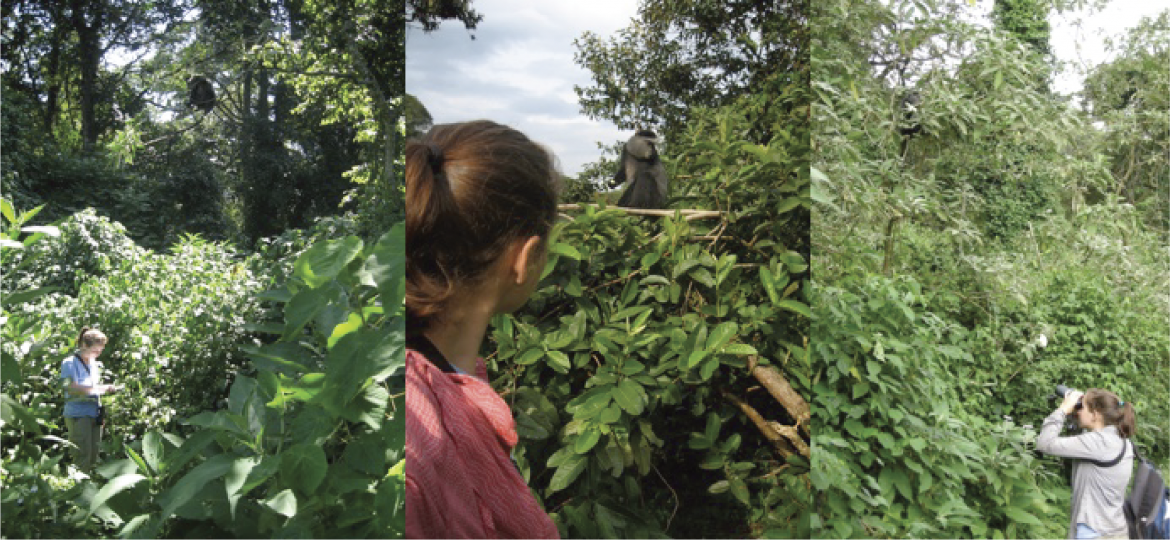
July 1, 2022 marks Kaitlyn Gaynor’s first day as an Assistant Professor in the Departments of Botany and Zoology at UBC. Her office and lab will be located in the Biodiversity Research Centre, and she will be joining the Interdisciplinary Research Solutions (IBioS) Cluster. Before joining us, Kaitlyn was a postdoctoral fellow at the National Center for Ecological Analysis & Synthesis (NCEAS) in Santa Barbara, California. Kaitlyn completed her BA at Columbia University and her PhD at the University of California, Berkeley.
We had the chance to sit down with Kaitlyn and learn more about her scientific journey, current work, and exciting plans when she joins us at UBC. After our interview, Kaitlyn was heading to Mozambique to do some field work before coming back to Vancouver later in the summer.
Of all the places you have lived in, which one is the most exciting and why?
The year that I spent living in the Kakamega Forest in western Kenya was really formative for me as a scientist. As an undergraduate, I was interested in animal behaviour—understanding why animals make the decisions that they make, and how these decisions are shaped by evolutionary and ecological contexts. I had a particular interest in primates, as our closest relatives, and I studied vigilance behaviour in blue monkeys in Kakamega for my undergraduate thesis. I loved the monkeys and forest life, and so after I graduated, I took a job as the manager of the field research project. In that year, my research interests slowly evolved. As I watched these monkeys go about their lives in landscapes that were so transformed by human activity, I couldn’t help but notice how much human infrastructure, habitat change, and the presence of humans were shaping the way these monkeys interacted with their environment, with each other, and with people.
That observation motivated the research that I decided to pursue in graduate school, focused on how anthropogenic disturbance changes animal behaviour and species interactions, and the consequences of those changes for conservation and human-wildlife interactions. That line of inquiry remains a focus of the research program that I will be starting at UBC. I'm still really interested in fundamental questions in animal behaviour and ecology, but as the human population and footprint grows, it's important to think about the outsized role that humans are playing in ecological communities around the world.
How are you planning to understand “the perspective from the other animals” besides humans?
I’ve used a range of tools in my research to try to understand animals’ interactions with their environments. I started with observational research, watching monkeys in the rainforest and recording data on what were they doing. Increasingly, I’ve been moving towards tools that allow us to monitor animals remotely, like GPS collars that record an animal’s location in space and time, and motion-activated wildlife cameras. You will never fully get the minds of other animals, and it is difficult to resist the temptation to anthropomorphize other animals and assume they are making decisions that would seem rational to us. But by exploring the contexts in which they are exhibiting different behaviours, we can better understand how environmental variability, along with a species’ biology and evolutionary history, is shaping the decisions that animals make. And this work is motivated by the desire to understand animal decision-making as they navigate human-altered landscapes.
One important factor that shapes animal decision-making, movement, and behaviour is their perception of risk. A big thrust of my research is understanding how human disturbance is reshaping “landscapes of fear.” We can be scary to wild animals, as can human infrastructure and its associated sensory stimuli. People are also changing landscapes of fear for prey by removing predators in places where we don’t want them, introducing invasive predators, or putting predators back in places where they used to be. And habitat alteration is modifying the playing field of predator-prey interactions, possibly altering prey perceptions of risk. All of that is changing the way that animals are navigating risk. So in our research, my colleagues and I apply theory from predator-prey ecology to these novel contexts to understand and predict how animals’ behaviour changes as a result of human-induced changes in risk and risk perception. In some cases, we may be able to alter the ecology of fear to improve outcomes for human-wildlife coexistence. For example, we may want animals to be less afraid of people so that they use an area that has critical habitat, or we may want them to be more afraid so they stay away from places where they are causing challenges for people.
You also look into the human perspective towards animals; can you explain this a little more?
I would be missing something if I studied human-wildlife interactions and only focused on the wildlife side. You need to explore the human side as well, in order to fully understand the drivers and outcomes of these interactions. People are constantly taking actions that affect the natural world, including animals and the decisions that animals are making, and resulting human-wildlife interactions can have important outcomes for animals, people, and ecosystems. I am not a social scientist myself, but I have been collaborating with researchers who study human behaviors, beliefs, attitudes, and values to understand the social-ecological dynamics of human-wildlife interactions. For conservation to be successful, it's critical to consider the needs and perspectives of people too. I am hopeful that being hired as part of the new IBioS cluster at UBC will facilitate engagement with social scientists and researchers across disciplines.

Kaitlyn, back in 2009, studying vigilance behaviour in blue monkeys in Kakamega for her undergraduate thesis
Do you ever compare, maybe just in your mind, your experience when working in Africa and in North America? Do you find more similarities or differences when it comes to human-wildlife interactions?
I have not done much systematic comparison of the systems where I have done fieldwork, but I have of course made observations as a researcher working in various contexts. I'm often more struck by the surprising similarities than by the obvious differences. In one global study, for example, I was surprised to find a really consistent effect of human activity on the daily activity patterns of large mammals—animals all around the world were more nocturnal in response to people, regardless of taxon and type of disturbance. At the same time, I’m also struck by how variable human-wildlife interactions are in a given place, as different species or even individual animals cope with the same human disturbance in different ways, and different stakeholder groups or individual people have a wide range of perspectives on animal conservation. So in a sense, I suppose a common thread across systems is the complexity and diversity of human-wildlife interactions in those systems. In last three years as a postdoc at NCEAS, I’ve been doing more comparative work, combining different data sets from systems around the world to try and understand how human-wildlife interactions vary across different contexts—ecological contexts, human contexts, and animal species.
In your website, I found that one of your main projects explores the idea of “conservation versus recreation”. Can you tell us more about that project?
Over the last few years, I’ve become interested in how we can better balance biodiversity conservation and recreation in protected areas. My focus has been on national parks in the United States, where visitation has been growing—even more so since the pandemic, with more people recognizing the benefits of outdoor recreation for physical and mental health. While increasing access to outdoor recreation opportunities is very important, recreation may have impacts on wildlife that extend beyond the physical footprint of infrastructure and can have consequences for the persistence of animal populations and ecosystem functioning. To better understand how recreation shapes animal behavior, I've been involved in a project where we are compiling animal movement data across national parks in the United States. We are trying understand how different species of large mammals respond to the built environment, including trails, campgrounds, and roads, and to patterns of visitor use, and we are leveraging the early pandemic 2020 park closures as a natural experiment to understand the consequences of removing visitors from the landscape. Stay tuned for the modeling results soon!
I’m thinking back to your first field experience in Africa, which influenced your research so deeply. When you join UBC, do you have a sense of how much will you continue doing in terms of field work, lab work, and modelling or theoretical work?
I started as a field biologist, but more recently, as a fellow at NCEAS—which is a data synthesis centre—I have been doing more synthetic work with existing data. At UBC, I would like to balance both fieldwork and data synthesis, while advancing both scientific theory and conservation outcomes. By bringing different data sets together, we can often come to a greater understanding than we could by looking at any one on its own. A lot of time, effort and public funding has gone into collecting many data sets that have a lot more life in them, and I am interested in how we can combine data in new ways. At the same time, fieldwork is a great way to engage students and ignite passions—as you mentioned, it was really key for getting me interested in ecology. While I was living in California, I did a lot of local research there in addition to my fieldwork in Africa, and I find local fieldwork to be a great way to involve many students and build community close to home. I'm keen to work locally once I arrive at UBC, although I am still in the learning phase. I would like to spend some time understanding the key conservation challenges and important human-wildlife interactions, and building relationships with people in and outside of UBC to figure out how my expertise and my research can best contribute to addressing conservation problems here.
What attracted you to UBC Zoology and Botany?
UBC has an amazing history of top-notch research. But beyond the ongoing contributions to science, what struck me the most was just how welcoming, collaborative, and supportive the community is here. From the very first conversations I had with people at UBC, I realized this is a place where my research group would be supported to explore new interdisciplinary pursuits, to take risks, to build community in and outside of UBC, to advance diversity and inclusion in our field. It is rare that you get this depth of expertise and brilliance in a group of people that is, at the same time, kind and welcoming. And I'm really excited to be based in Zoology and Botany, where my research can continue to be shaped by fundamental ecological theory and advance our knowledge about the natural world, and to be joining the unique IBioS cluster, where we can think about how to apply this knowledge to solving current environmental problems.
Video UBC Science, Sep 23, 2022 - Finding solutions for coexistence